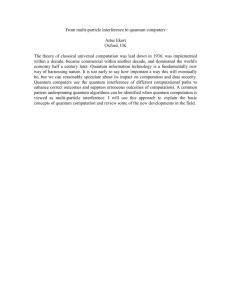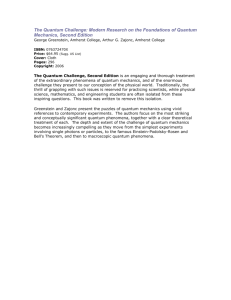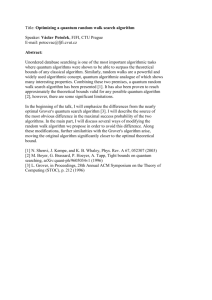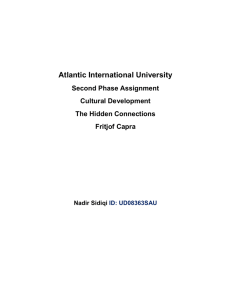4-New Age Science (1)
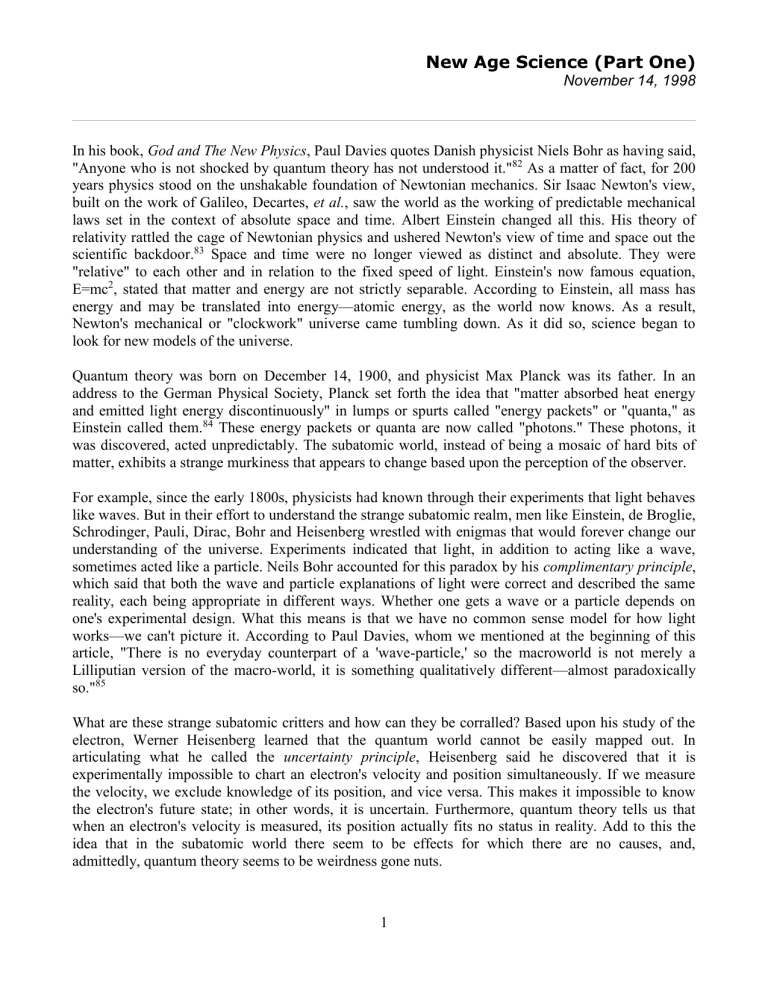
New Age Science (Part One)
November 14, 1998
In his book, God and The New Physics , Paul Davies quotes Danish physicist Niels Bohr as having said,
"Anyone who is not shocked by quantum theory has not understood it." 82 As a matter of fact, for 200 years physics stood on the unshakable foundation of Newtonian mechanics. Sir Isaac Newton's view, built on the work of Galileo, Decartes, et al.
, saw the world as the working of predictable mechanical laws set in the context of absolute space and time. Albert Einstein changed all this. His theory of relativity rattled the cage of Newtonian physics and ushered Newton's view of time and space out the scientific backdoor.
83
Space and time were no longer viewed as distinct and absolute. They were
"relative" to each other and in relation to the fixed speed of light. Einstein's now famous equation,
E=mc
2
, stated that matter and energy are not strictly separable. According to Einstein, all mass has energy and may be translated into energy—atomic energy, as the world now knows. As a result,
Newton's mechanical or "clockwork" universe came tumbling down. As it did so, science began to look for new models of the universe.
Quantum theory was born on December 14, 1900, and physicist Max Planck was its father. In an address to the German Physical Society, Planck set forth the idea that "matter absorbed heat energy and emitted light energy discontinuously" in lumps or spurts called "energy packets" or "quanta," as
Einstein called them.
84
These energy packets or quanta are now called "photons." These photons, it was discovered, acted unpredictably. The subatomic world, instead of being a mosaic of hard bits of matter, exhibits a strange murkiness that appears to change based upon the perception of the observer.
For example, since the early 1800s, physicists had known through their experiments that light behaves like waves. But in their effort to understand the strange subatomic realm, men like Einstein, de Broglie,
Schrodinger, Pauli, Dirac, Bohr and Heisenberg wrestled with enigmas that would forever change our understanding of the universe. Experiments indicated that light, in addition to acting like a wave, sometimes acted like a particle. Neils Bohr accounted for this paradox by his complimentary principle , which said that both the wave and particle explanations of light were correct and described the same reality, each being appropriate in different ways. Whether one gets a wave or a particle depends on one's experimental design. What this means is that we have no common sense model for how light works—we can't picture it. According to Paul Davies, whom we mentioned at the beginning of this article, "There is no everyday counterpart of a 'wave-particle,' so the macroworld is not merely a
Lilliputian version of the macro-world, it is something qualitatively different—almost paradoxically so."
85
What are these strange subatomic critters and how can they be corralled? Based upon his study of the electron, Werner Heisenberg learned that the quantum world cannot be easily mapped out. In articulating what he called the uncertainty principle , Heisenberg said he discovered that it is experimentally impossible to chart an electron's velocity and position simultaneously. If we measure the velocity, we exclude knowledge of its position, and vice versa. This makes it impossible to know the electron's future state; in other words, it is uncertain. Furthermore, quantum theory tells us that when an electron's velocity is measured, its position actually fits no status in reality. Add to this the idea that in the subatomic world there seem to be effects for which there are no causes, and, admittedly, quantum theory seems to be weirdness gone nuts.
1
Albert Einstein felt the same way. In 1935, Einstein and two of his colleagues, Podolsky and Rosen, produced a thought experiment, later known as the EPR experiment, that was designed to demonstrate that quantum theory is incomplete and needs an underlying theory of hidden variables in order to tell the whole truth.
86
In the EPR experiment, an atomic particle would split into two pieces, A and B, which would fly apart from each either. Since they originated from the same particle, A and B are correlated. Theoretically, A and B would have the same speed and distance from their origin at any given instant, but in different directions. Although Einstein conceded that the velocity and position of an atomic particle cannot be measured at the same time, nevertheless, he believed that the particle had both a real velocity and a real position, all at the same time. The EPR experiment would allow the velocity of A to be determined (thereby rendering its position unknown) and the position of B to be determined (thereby rendering its velocity unknown). Because both A and B would be traveling at the same speed and would be at the same distance from the origin, we would then know directly and indirectly the actual velocity and position of each particle. What can be measured, whether directly or indirectly, must be considered real .
To make a long story short, in 1965, a decade after Einstein's death, physicist John Bell proved a mathematical theorem that indicated Einstein's hidden variables concept would yield results at odds with those predicted by quantum theory. During the seventies, as advances in technology enabled experiments to be conducted to test Bell's theorem, several experiments were indeed conducted along the lines of the EPR proposal. But, by far, the best experiment was carried out by Alain Aspect and colleagues at the University of Paris. Aspect used two photons of light emitted simultaneously by an atom. When one of the photons was affected by a polarizing filter, the other was correspondingly affected. Whatever happened to one instantly happened to the other (i.e. there seemed to be a remote control without any apparent control mechanism). Aspect's experiment says that, in the subatomic world, if one photon is stopped, then the other photon stops instantly—without any physical connection. The absurdities that Einstein hoped would discredit quantum theory (e.g. events without causes, ghost images, reality triggered only by observation) turn out to be not only absurd but apparently true!
I say apparently because there are already tell-tale signs that the quantum paradigm (world view) will soon be replaced. Already there are physicists who are seeking new images and concepts that will tie things together as Einstein had hoped to do. The particle-wave duality may not be two separate complementary aspects of the same subatomic entity; instead, the "wavicle"' may be a projection of a single unified phenomenon residing in a "higher dimensional region." 87
But before you dismiss quantum theory with, "Aha, just what I thought, a bunch of mumbo-jumbo," it would be wise to realize that quantum theory has never made an incorrect prediction. And although quantum theory is one of the most difficult and technical subjects to understand, it is, nevertheless, one of the most brilliantly successful scientific theories ever devised. At one stroke it explained chemical bonding, the structure of the atom and nucleus, the conduction of electricity, the mechanical and thermal properties of solids, the stiffness of collapsed stars and a host of other important physical phenomena.
88 But its success has been more than theoretical. On a practical level, it has given us the laser, the electron microscope, the semiconductor, the transistor, the superconductor, and nuclear power. So we learn that the "new physics" is not new at all. In the past 60 years it has penetrated most areas of scientific inquiry, at least in the physical sciences, and is now taught in our universities as a matter of course. Quantum theory has a vast body of supporting evidence, not just from commercial gadgetry, but from careful and delicate scientific experiments.
89
In other words, many concepts of quantum theory are going to be with us for awhile.
2
The Tao of Physics and the Dancing Wu Li Masters
Many New Agers have picked up on and exploited the close parallels between the concepts used in quantum physics and those in Eastern mysticism and the occult. Marilyn Ferguson has said that
"science is only now verifying what humankind has known intuitively since the dawn of history."
90
In
Unmasking the New Age , Douglas Groothuis wrote:
Books such as Fritjof Capra's The Tao of Physics and Michael Talbot's Mysticism and the New Physics argue that new theories about the nature of the cosmos have opened the scientific community to some new ideas: the unity of all things, the nonexistence of an independent external world and the unity of opposites. In other words. science has been brought face to face with ancient mysticism.
91
In his book The Turning Point , Fritjof Capra wrote:
Subatomic particles... are not "things" but are interconnections between "things," and these "things," in turn, are interconnections between other "things," and so on. In quantum theory you never end up with
"things"; you always deal with interconnections.
92
Capra believes that because we cannot cut up the universe into "independently existing smaller units," we have no choice but to see its "basic oneness."
93
In his popular and influential book The Tao of
Physics , Capra sets statements by physicists next to those of Buddhist, Taoist, and Hindu mystics and finds mutually supportive testimony for the oneness of all things, the unity of opposites
(complementarity), the relativity of space and time, and the ever-changing nature of reality.
94
Capra's claims are bolstered by the ideas of theoretical physicists like David Bohm, who believe that the relativity and quantum theories "imply the need to look on the whole world as an undivided whole, in which all parts of the universe, including the observer and his instruments, merge and unite in one totality." 95
Capitalizing on an interpretation of Heisenberg's uncertainty principle and the influence of the observer on the subatomic realm, Capra, himself a physicist, says, "The electron does not have objective properties independent of my mind."
96
That such thinking represents the ideas of some of those on the
"cutting-edge" of quantum theory is illustrated by the remarks of Fred Allan Wolf, who, concerning the implications of Schrodinger's ideas concerning quantum theory, wrote:
[T]he position of wholeness taken by Schrodinger call quantum solipsism. According to solipsism, the self is the only thing that can be known and verified ... Everything depends on you. You create the universe; you are the "you-niverse."
97
According to George Leonard, a longtime New Age activist and author who believes each of us "is the entire universe," and "we are like a God, omnipotent and omniscient," 98 when one adds to quantum theory the breakthrough known as the holographic paradigm, the "idea of all-in-oneness"
99
seems to be a very tightly wrapped package. The hologram, discovered through photographic experiments, is a three-dimensional projection resulting from the interaction of laser beams. As a result of these experiments, it was learned that the entire hologram could be produced from any one of its component parts. In other words, "Each part of the hologram, no matter how small, can reproduce the whole image when illuminated by laser light."
100
This lead Leonard to compare the hologram "to the Hindu idea of the Net of Jewels, in which every jewel, every piece of the universe, contains every other piece." 101
The hologram paradigm has caused Stanford neuro-scientist Karl Pribram to speculate that the brain functions holographically. Not stopping there, he has further speculated that "maybe the world is a hologram." 102
3
According to many New Age thinkers, all that can be known is potentially contained in consciousness.
According to Leonard, in a holographic universe, "information about the whole is available at its every point."
103
And according to Michael Talbot, "The new physics suggests that consciousness contains a
'reality structurer,' some neurophysiological mechanism which psychically affects itself."
104
It is this kind of thinking that has opened the floodgates for the study of the psychic and paranormal in our universities. Paranormal manifestations, referred to as psi or, more traditionally, as extrasensory perception (ESP), have increasingly attracted the attention of the scientific community. Following in the shadow of J. B. Rhine's early work at Duke University, a host of psychic researchers are currently vying for scientific respectability. A large degree of respectability was gained by this field when, in
1969, the prestigious American Association for the Advancement of Science made the
Parapsychological Association a member organization.
105
Contrary to the general expectations that the advance of science would cause religion to die out, science and religion are remeshing. But, instead of joining with a religious world view influenced by the Bible, modern science, awe-struck by its findings, is joining with Eastern and occultic mysticism.
According to Bam Price, an associate of Edger Mitchell (former astronaut turned psychic researcher):
The powers described by the mystics through the ages are now being described by scientists, proof that underlying the material world is a vast nonsubstantial world. The priests of old were also the scientists.
Today the priest and the scientist are coming back together again.
106
In essence, it has taken science a hundred years to catch up with Mary Baker Eddy, the founder of the religion of "Christian Science" and reviver of heretical gnosticism, whose writings were an attempt to move Biblical theism in the very direction that science is now moving—to the East. According to prominent New Age thinkers, science and Eastern mysticism are currently having a love affair, but very soon now they will take part in a wedding that will forever destroy the Western ("Christian") world view.
But upon a closer look, one discovers that this tightly wrapped package is not so tightly wrapped after all. In fact, New Age writers, like Capra, Talbot, et al , at times present controversial and contested scientific theories as though they are scientific facts. For example, the interpretation of Heisenberg's uncertainty principle and the influence the observer of the subatomic world makes on that realm has caused many New Age activists to assume that consciousness itself affects the quantum realm or even that "reality" actually springs into existence through acts of thinking. Remember, Capra, as we previously quoted, thinks "the electron does not have objective properties independent of [his] mind."
107
This, of course, is contested by many physicists. A distinction must be made between the influence the tools of observation make on the quantum world and the influence of the consciousness of the observer. This is clarified by Ian Barbour, who wrote:
The "involvement of the observer" refers to observation processes and not to mental states as such. The
"frame of reference" means the measuring apparatus —clocks, meter, sticks, photographic plates—not minds or persons ... It is the detection apparatus, not the observer as a human being, which influences the measurement obtained.
108
Robert John Russell, in criticizing Gary Zukav's popular book, The Dancing Wu Li Masters (a book that also finds parallels between science and Eastern mysticism), says that "one does not find [in
Zukav's book] a distinction made between experimental results and the interpretations based on them."
Russell cites, as an example, Zukav's agreement with Eugene Wiger and John Von Neuman on the
"central role of consciousness on elementary physical phenomena," which is an interpretation that is
4
disputed by many physicists.
109
Douglas R. Groothuis is correct when he says "the new physics is metaphysically taxed for more than it is worth."
110
The road from physics (the scientific study of the creation) to metaphysics (the nature of all reality) is not as easy to travel as many New Agers would have us believe. In other words, "To extrapolate from what is empirically observable to everything that is involves a logical non sequitur ."
111
Furthermore, in the realm of theoretical physics, we are dealing with "things" no one has ever seen (subatomic particles are inferred from hydrogen bubbles that scientists can see), theorizing is not purely an objective matter of empirical observation. The world view of the scientist necessarily influences his studies. Capra admits to his bias in The Turning Point :
My presentation of modern physics ... has been influenced by my personal beliefs and allegiances. I have emphasized certain concepts and theories that are not yet accepted by the majority of physicists, but that I consider significant philosophically, of great importance for the other sciences and for our culture as a whole.
112
No one can fault Capra for his honesty. If every scientist would admit his prejudices, we would have a lot more science and a lot less scientism today. Value-free science, the sacred cow that doesn't exist, is not possible because, as philosopher Arthur Holmes has said, "science itself is a human enterprise dependent on beliefs and values—even on the world views—that scientists themselves bring to science rather than simply drawing from their work."
113
In his landmark 1962 essay, The Structures of Scientific Revolutions , science historian and philosopher
Thomas Kuhn argued that revolutions in scientific thought (which he called "paradigm shifts") often result from psychological and sociological influences rather than from empirical or logical factors. In this regard, it is interesting to note the mystical experience that Fritjof Capra admits instructs the world view he superimposes on his science:
I "saw" the atoms of the elements and those of my body participating in this cosmic dance of energy; I felt its rhythm and I "heard" its sounds, and at that moment I knew that this was the dance of Shiva, the
Lord of Dancers worshipped by the Hindus.
114
It is this mystical experience that affected Capra's later integration of physics and mysticism.
Therefore, it should not surprise Capra that his interpretation of modern physics is somewhat suspect.
Of course, this is not to say that one should opt for total skepticism when it comes to scientific theories; instead, one must carefully consider scientific claims in their overall context. And although quantum mechanics now commands the day, it must be remembered that scientists differ as to just how it ought to be interpreted. Some, like Winger and Schrodinger, see it as demanding solipsism (all is mind); others remain unconvinced that such is the case. Some, like Bohr and Heisenberg, see it as revealing a chance universe; others like Einstein and Bohm do not. According to Ken Wilber, himself a
New Age theorist:
To hook transpersonal psychology/mysticism to the consensus of the new quantum mechanics is not possible, because there is no consensus. Those connections that have been drawn between physics and mysticism are of the pick and choose variety.
115
Furthermore, scientific theories are often short-lived. Theories considered to be on "the frontiers of science" today, may be tomorrow's wastelands. Hallmarks have a way of becoming tombstones when it comes to scientific theories. As a result, if one's god is the god of today's physics, then when that
5
construct of physics becomes passe, so will that god. This is amplified by philosopher Gordon Clark's observation:
(S]o rapid and so extensive have been the changes in physics since the abolition of ether and the invention of wavicles that one may confidently affirm that, whereas Newtonianism lasted for two centuries, no theory, today seems likely to last two decades.
116
Notes
82
Paul Davies, God and the New Physics , 1983, page 100.
83
Groothius, op. cit.
, pages 9o-95.
84
Ibid.
85
Paul Davies, Other Worlds , 1980, page 75.
86 Alien Emerson, "A Scientific Showdown," Christianity Today Magazine, February 1, 1985, pages
24-25.
87
Allen Emerson, "A Disorienting View of God's Creation," Christianity Today Magazine, February 1,
1985, page 23.
88
Davies, God and the New Physics , page 101.
89
Ibid.
90
Marilyn Ferguson, op. cit.
, page 152.
91
Groothius, op, cit.
, page 94
92
Fritjof Capra, The Turning Point , 1982, page 80.
93
Capra, op. cit.
, pages 80-81.
94 Capra, The Tao of Physics , 1975, pages 130-301.
95
David Bohm, Wholeness and the Implicate Order , 1980, page 11.
96
Capra, Turning Point , page 87.
97 Fred Allan Wolf, Taking the Quantum Leap , 1981, page 183.
98
George Leonard, The Silent Pulse , 1981, page 105.
99
Leonard, op. cit.
, page 69.
100
Leonard, op, cit.
, page 68.
101 Leonard, op. cit.
, page 69.
102
Quoted in Ferguson, op. cit.
, page 180.
103
Leonard, op. cit.
, page 73.
104 Michael Talbot, Mysticism and the New Physics , 1981, page 14.
105
Jean Shinoda Bolen, The Tao of Psychology: Synchronicity and the Self , 1979, page 75.
106
Quoted in Dave Hunt, The Cult Explosion , page 9.
107
Capra, Turning Point , page 87.
108
Ian C. Barbour, Issues in Science and Religion , 1966, page 287.
109
Robert John Russell, "The Dancing Wu Li Masters: An Overview of the New Physics," a book review in Zygon , December 1980, page 442, quoted in Groothius, op. cit.
, page 101.
110 Groothuis, op. cit.
, page 104.
111
Arthur F. Holmes, Contours of a World View , 1983, page 41.
112
Capra, Turning Point , page 96.
113 Holmes, op. cit.
, page 49.
114
Capra, The Tao of Physics , page 11.
115
Ken Wilder, ed., The Holographic Paradigm and Other Paradoxes , 1982, page 178.
116
Gordon H. Clark, "The Limits and Use of Science," Horizons of Science , Carl Henry, ed., 1978, page 263.
<>Allan Turner
6
7




